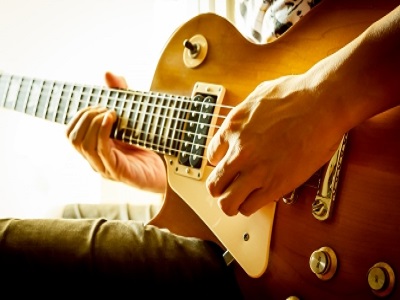Left And Right Hand Positioning for Classical Guitar Playing
 Like all properly implemented guitar techniques, the left hand positioning on the guitar goes a long way to helping a guitarist avoid injury.
Like all properly implemented guitar techniques, the left hand positioning on the guitar goes a long way to helping a guitarist avoid injury.
Tennis players have to worry about tennis elbow, football players have to worry about ACL strains, and we need to worry about the dreaded carpal tunnel syndrome. With a few basic pointers, you can begin yourself on a long track of healthy classical guitar playing.
Let’s take a look at the left hand positioning basics first…
Thumb Placement Behind the Fretboard is Important
First of all, when you play guitar, under no circumstance should your thumb ever peak over the top of your fret board. This not only puts an unnatural strain on your wrist causing the carpals to become compressed, but it also leads to poor fingering technique.
Your wrist should shift as little as possible, your thumb gliding along the contour of the back of the neck. This avoids extreme angles and stops you from straining your wrist, which is full of delicate tendons and nerves, all of which can be easily damaged if subjected to gross contortion.
There are no songs which will ever require you to lift your thumb above the back of the neck, and if you find one, its better to steer clear, as you will come to see the composer with wrist splints soon enough. When you need to reach the lower frets simply rotate.
Next Up is Proper Finger Positioning For the Left Hand
The worst thing guitarists are guilty of –and I used to be guilty myself as well once upon a time– is the need to look impressive while playing. Let’s face it; fast, far flying digits look neat. They also cause wrist strains and other injuries. Keep ergonomics in mind, making each motion as comfortable and relaxed as possible. A good foundation in this will also help in advanced guitar playing techniques such as legato playing.
Chances are, the frets you are trying to jump between can be played closely together by playing on of the notes on a different string. It may not look impressive, but then again neither does playing not guitar and living with a wrist four sizes too large.
The final and perhaps one of the most overlooked aspect of left hand basics is fretting power. You should not be white knuckling the strings into submission.
Use as Little Power as Possible to Fret the Strings Without it Buzzing
You want clean ringing notes, but you don’t want to break your fingers to achieve this. Also, your fingers should curl around to the fret board. You should have the appearance of a claw when fretting. Your fingers shouldn’t be flat and sticking straight down. This is not only bad form but also leads to more playing related injuries.
Keeping your wrist on an angle with your fingers arched evenly disperses the vibration made by the strings throughout your entire arm. If you are choking down on the strings with your fingers with your wrist bent on an extreme angle, all of the tension and vibration will gather itself in the tissues of your wrist.
Remember, as with all aspects of guitar, proper left hand positioning on classical guitar takes not only patience and practice but awareness as well. You need to pay attention to your form and be sure to correct yourself the instant you notice yourself lapsing into poor form, because a lapse can easily become a habit.
Right Hand Positioning Tips For Classical Guitar Players
Our string picking hands are not only important, but actually the lifeblood of our playing. We need them to be accurate and resilient, not to mention strong. In classical guitar playing, accents are played with the right hand. So are ghost notes. This means that we need to not only have strength but also the ability to pluck with subtlety.

The first, biggest mistake I see in guitarists new to the classical guitar is that they tend to rest their hands against the strings. Playing a classical guitar is nothing like playing an electric guitar.
In fact, resting your palm against the strings only hinders your ability to properly finger the strings. If a floating hand is uncomfortable, try resting your thumb against the low E string and your ring finger, middle finger and forefinger against the B string. Your pinky is never to make contact with the strings, so consider it exiled.
Playing a Chord With Ease
The simplest technique involving your right hand is playing a guitar chord. Before you go and try to strum, listen up; strumming is not a technique within the world of classical guitar. When you play a chord, you will take the strings involved designating a finger per string, the lower the string, the further from your pinky the designated finger will be.
When you play the chord, you grab the involved string and, like turning a key in a door, twist the strings. Be sure to let go; if you don’t the strings are apt to twang out loudly, or snap back at your fingers.
The Next Basic Right Handed Technique is Proper Fingering
As stated earlier, your pinky will never be involved in any fingering. The reason for this is that it is such a fragile digit that there is more chance of injuring it than there is of actually achieving a usable technique.
Your thumb will always be designated to the lower notes, or the ‘bass notes.’ This is because, among other reasons, your thumb is the strongest of the fingers. It is also the most naturally independent. The most used fingers will be your forefinger and your middle finer.
Proper ring finger technique will take a lot of practice, as the pinky and ring finger are highly dependent on one another, and isolating the ring finger for clean playing is a whole other task in and of itself.
More often than not, you will be alternating between your forefinger and middle for the treble notes. When you finger the notes, you don’t want to use your nail, but the meat of your fingertip.
The best tip for finger independence on your right hand is to practice fingering even when you aren’t playing your instrument. If you know the pattern, half the battle is already won. Application is only a smaller part.
Finally, the best way to perfect your right hand classical guitar techniques is to practice. Be sure to set aside a block of time each day to not only practice finger, but practice power as well. You don’t want to snap strings or crack your nails; picking power is extremely important. Have fun, but most of all, work hard.







Leave A Comment